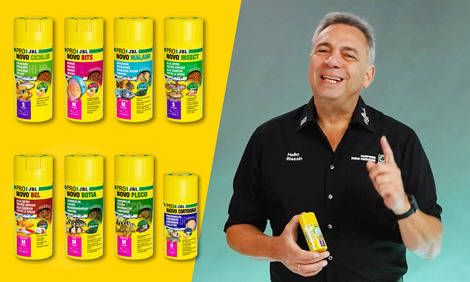Armored catfish are among the most popular fish in our aquariums. Beginners in particular like these small, lively bottom dwellers in their community aquariums. But what species are there and where do they live? Let's take a closer look at this topic.
Home of the armored catfish
These beautiful catfish are native to Central and South America. There they are mainly found in various rivers and streams, but also in stagnant waters with very few plants, large sandy areas and high levels of foliage. Accordingly, the proportion of humic substances in these waters is higher than in other waters.
What species are there?
Over 160 Callichthyidae, as the armored catfish and cascarudos are known, have now been scientifically proven. In addition to the armored catfish with the genera Aspidoras, Brochis, Corydoras and Scleromystax, this also includes the cascarudos, of which the genera Dianema and Hoplosternum are the best known.
The most popular armored catfish include the bronze corydoras (Corydoras aeneus), panda catfish (Corydoras panda), Sterba's cory (Corydoras Sterbai) and pygmy catfish (Corydoras pygmaeus).
Armored catfish and their second respiratory organ
Anyone who keeps armored catfish will have noticed that they occasionally swim towards the surface of the water to gasp for air. This is because they are able to absorb oxygen through their intestines as well as through their gills. Thus they can survive in stagnant waters with little oxygen.
How can I determine whether an armored catfish is male or female?
Determining the sex of armored catfish is relatively easy. In adult animals, females are clearly larger and stronger than males. This is much more difficult with juveniles.
What’s important for their care?
Armored catfish are bottom-dwelling fish which use their barbels to search for food on or in the substrate. That’s why it’s important to choose a smooth substrate without sharp edges. Fine sand is best, such as JBL Sansibar WHITE .
They are social creatures (except C. acutus) and should therefore definitely be kept as a shoal. But how many armored catfish form a shoal? On our 2022 JBL expedition to Colombia, we were able to observe the animals (Corydoras brevirostris) in the wild in Caño Bonito near Puerto Inirida. Several hundred animals swam past our camera lens. In aquariums as a general rule you need to keep groups of at least six fish. More is always better.
Read more about the JBL Expedition Colombia here: Wyprawa badawcza 2022 Kolumbia I & Wyprawa badawcza Kolumbia II
As armored catfish are usually found in waters with a high proportion of humic substances, it is advisable to add these substances to the aquarium in the form of water conditioners ( JBL Tropol ) or tropical almond leaves ( JBL Catappa XL ), for example.
Many armored catfish remain relatively small and can therefore be kept in aquariums from a length of 60 cm - 80 cm. As always, the same applies here: The bigger, the better!
Here an outline of how to keep popular armored catfish species*:
| Name | Fish size [cm] | Aquarium volume [litres] | Edge length [cm] | pH value | GH value [°dH] | Water temperature [°C] |
|---|---|---|---|---|---|---|
| Bronze corydoras (Corydoras aeneus) | 6 - 8 | from 54 | 60 | 6 - 8 | 5 - 15 | 25 - 30 |
| Panda catfish (Corydoras panda) | 5 | from 54 | 60 | 7 | 5 - 10 | 22 - 25 |
| Pygmy catfish (Corydoras pygmaeus) | 2 - 3 | from 54 | 60 | 6 - 7.5 | 2 - 15 | 24 - 26 |
| Sterba's cory (Corydoras sterbai) | 7 | ab 112 | 80 | 6.5 - 7.5 | 5 - 12 | 22 - 26 |
| Mottled corydoras (Corydoras paleatus) | 7 | from 112 | 80 | 6 - 7.5 | 0 - 15 | 20 - 26 |
*This overview corresponds to recommendations of the BMEL, DRTA archive & my-fish Fishotek. If you would like to find out more about the individual species from the keeper's point of view, you can use these links:
The right food for armored catfish - JBL PRONOVO CORYDORAS TAB M
Armored catfish are omnivores which ingest detritus (crushed organic matter) on or inside the substrate. This means that their food spectrum covers almost everything that can be found in natural waters. In JBL PRONOVO CORYDORAS TAB M , this is taken into account in the composition with plant and animal components.
If different bottom dwellers are kept in an aquarium, feeding them different foods is not a problem. Fish also have a sense of taste and will refuse food if it is not to their liking. In addition, we do not keep any bottom-dwelling species that could get into trouble by eating a food tablet for another species (e.g. loaches). Different types of tablet can therefore be fed at the same time. It is even good for the fish as they get more variety.
Nevertheless, it’s worth mentioning once again how essential the feeding is. A common misconception is that bottom dwellers such as armored catfish can be used as hoovers or waste recyclers.
All JBL PRONOVO foods are made from selected, natural raw ingredients and contain no artificial additives such as colourings. In addition, each food is prebiotic, which means that dedicated dietary fibres supply the beneficial intestinal bacteria with food, thereby promoting healthy digestion.
Find out more about feeding armored catfish in this video:
